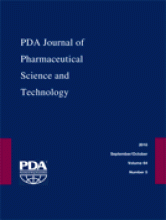Abstract
Out-of-specification (OOS) results were reported by a contract lab in the in vitro adventitious agent assay (AVA) for two products manufactured using mouse myeloma cells in perfusion bioreactors. Cytopathic effect observed for test article-inoculated MRC-5 monolayers resembled foci seen in tissue culture cells infected with transforming viruses. All reasonable known technologies, including highly sensitive, state-of-the-art methodologies and multiple, redundant, and orthogonal methods, were deployed to screen broadly for potential viral and microbial contaminants. Due to the appearance of apparent foci, testing for murine, bovine, and human polyomavirus contamination was heavily represented in the analytical investigation. The results obtained in this extensive screening provided convincing evidence for the lack of an infectious viral or other biological agent. Although the initial investigation produced no reason to invalidate AVA yielding OOS results or to suspect an assay artifact, an extended evaluation revealed several irregularities at the contract test lab reporting the OOS results. The extended investigation also included attempts to reproduce OOS results at alternate contract testing labs and an inter-laboratory study in which methodological differences in the AVA at the three different contract labs were investigated. Only the contract lab initially reporting the OOS results reported foci during this extended evaluation. The results of the inter-laboratory study suggested that the foci artifact might be attributed to the prolonged exposure of the MRC-5 monolayer to cell debris present in the test article. Confocal immunofluorescence microscopy and transmission electron microscopy were subsequently used to provide convincing evidence that the foci observed in test article-inoculated AVA wells were composed of a core of degraded myeloma cell debris covered by one or more layers of MRC-5 cells. The observation that the foci were detected in the AVA at a contract lab where the MRC-5 monolayer is exposed to production cell line debris for a prolonged period strongly suggests that these foci form when MRC-5 grow over the cell debris present in the test article. The cumulative results of the investigation supported the conclusion that the OOS results were artifacts of the AVA test system and not a result of contamination with a virus or other biological agent. Testing was discontinued at the contract lab generating the OOS results and validated at a second contract lab. Manufacturing resumed in consultation with health authorities. The lots were retested following a standard operating procedure (SOP) already in place and ultimately dispositioned for use in normal distribution channels.
- © PDA, Inc. 2010
PDA members receive access to all articles published in the current year and previous volume year. Institutional subscribers received access to all content. Log in below to receive access to this article if you are either of these.
If you are neither or you are a PDA member trying to access an article outside of your membership license, then you must purchase access to this article (below). If you do not have a username or password for JPST, you will be required to create an account prior to purchasing.
Full issue PDFs are for PDA members only.
Note to pda.org users
The PDA and PDA bookstore websites (www.pda.org and www.pda.org/bookstore) are separate websites from the PDA JPST website. When you first join PDA, your initial UserID and Password are sent to HighWirePress to create your PDA JPST account. Subsequent UserrID and Password changes required at the PDA websites will not pass on to PDA JPST and vice versa. If you forget your PDA JPST UserID and/or Password, you can request help to retrieve UserID and reset Password below.






